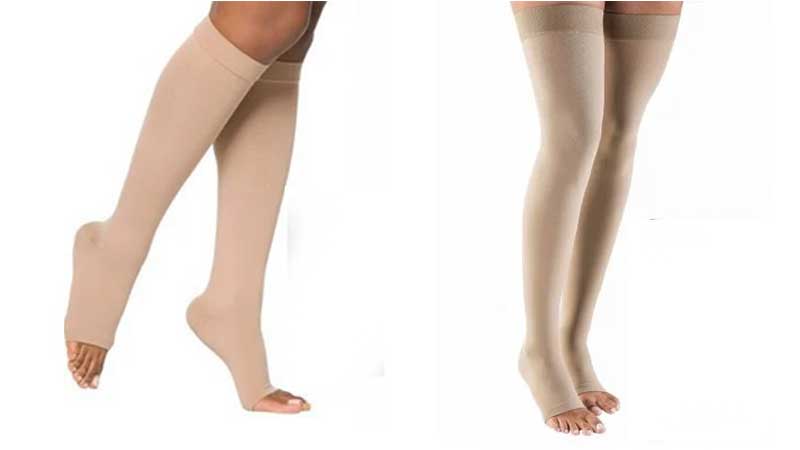Compression socks are one of the most helpful inventions for travellers. All over the world, several frequent travellers use compression stockings for travel. Travel brings adventure and novelty to our mundane lives, but that doesn’t eclipse the swelling and leg cramps we must endure due to the journey.
Compression socks benefit patients suffering from venous insufficiencies and frequent travellers who are always on the go for adventure or work.
Have you ever wondered what causes our ankles and feet to swell up after a long flight or car ride? Well, It’s the blood circulation or, in this case, the lack of it!
Our calf muscles are the main pump for blood flow in our legs. The muscles constrict the veins, pushing the blood up the legs and back toward the heart as we walk. While travelling, our movement is restricted, and our calf muscles stay inactive. This immobility causes blood to pool in the legs, affecting proper blood circulation.
Being cramped in a confined space for long hours increases the risk of developing cramps, swelling, and, even worse, deep vein thrombosis (DVT). Deep vein thrombosis (DVT) is caused when a blood clot forms in one or more of the deep veins in your body, generally in your legs.
Yeah, this does sound scary! Therefore, we will tell you how to choose the right compression socks for travel in 2023 and what compression socks benefits you can get by wearing one.
What are Compression Socks?

Compression stockings apply controlled pressure to your legs. This pressure is graduated, which means that it exerts the most significant degree of compression at the ankle, and then this compression gradually reduces as you go up the leg. This structure helps boost blood circulation even when you are not moving for hours. As a result, these socks relieve heaviness and swelling and significantly reduce the risk of developing venous conditions.
Doctors have always been prescribing compression garments to manage vein-related medical conditions. It’s time we borrow their secret and give our legs the gift of pain-free travel.
Now that we are well acquainted with compression stockings let’s look at the different types available and find out the best compression stockings for travel. But before we discuss the types of compression socks for travel, let us understand the benefits of compression socks and why is it essential to wear them while flying.
Why Should You Wear Compression Socks For Flying?
Firstly, what are flight socks? Compression socks for travel help boost leg blood circulation because prolonged sitting or lying down reduces blood flow. Airplane compression socks are great for avoiding blood clots and the chances of developing fluids in the lower legs. There are various reasons why wearing compression stockings can benefit you. Factors like age, obesity, and pregnancy are some of the basis for wearing compression socks for travel.
Additionally, if there is a family history of individuals with DVT and varicose veins, you must wear compression socks for flying. Also, if you are a frequent flyer, airplane compression socks can make you feel comfortable and reduce muscle fatigue and swelling.
What Are The Benefits Of Compression Socks While Flying?
Wearing compression socks while travelling or flying provides the following benefits:
Reduces Fatigue & Swelling
If you’ve ever had more swelling than usual after a long flight, it’s likely due to poor blood circulation and blood pooling in the lower extremities. One significant benefit of compression socks is that the graduated pressure on the ankles and feet encourages blood flow. As the movement in an aircraft is limited, wearing compression stockings will ensure smooth and unrestricted blood circulation in the legs.
Secondly, as compression socks boost circulation, they naturally reduce muscle fatigue. It provides gentle compression to the feet, ankles and calves. The circulatory system brings depleted blood back to the heart to be oxygenated and recirculated to the body’s tissues and muscles. As a result, the calf muscles are happy and free of swelling and weariness.
Prevention Against Varicose Veins & Blood Clots
This one is probably the most important in the list of benefits of compression socks. External pressure on the calf and feet reduces the risk and chances of developing blood clots due to poor blood circulation. Compression socks improve blood circulation, reducing the risk of varicose and spider veins. They supplement the blood pressure, which increases circulation.
Types of compression socks

Non-Medical Support Stockings
This type of compression garment provides mild compression to your legs. As the name suggests, they are meant to support your veins and aid blood circulation, consequently avoiding pain, heaviness, and swelling.
Anyone can use these compression stockings, and they do not need to be worn under the guidance of a doctor. Support hosiery is where your regular socks and medical compression stockings meet because people wear this type even for everyday wear. In addition, it serves as a preventive measure and reduces the risk of developing any venous conditions in the future.
Medical Compression Stockings
Medical compression stockings are available in different compression levels with moderate to firm compression. These garments are meant to provide measured, controlled compression; therefore, the sizing is based precisely on leg measurements.
Medical compression garments should be worn under the guidance of your doctor. They commonly manage medical conditions such as varicose veins, lymphedema, venous ulcers, and deep vein thrombosis.
Lymphedema stockings come in different styles, like arm sleeves and compression wraps, to apply graduated compression to the affected limb to reduce swelling and improve lymphatic drainage. These compression stockings benefit in minimizing tissue damage and the progression of lymphedema.
Anti-Embolism Stockings
This type of compression stocking is designed for bedridden or immobile patients. They are commonly used for patients after they have undergone surgery.
We now have a basic understanding of compression stockings and their various types. Let us now focus on the specificities to look for while buying compression socks for travel.
How To Choose The Right Compression For Travel?
1. Choose The Proper Compression Level
The compression level determines the amount of pressure the stockings will apply on your legs. Whenever you buy compression stockings, you will see something like mmHg, millimetres of mercury. The higher the mmHg value of the compression stockings, the stronger the compression.
If you are a healthy adult with no pre-existing venous problem, you should choose support stockings for travel. They will be ideal for preventing pain and swelling in the legs, keeping your legs light and energized.
However, if you already have a vein-related condition and have been prescribed medical compression stockings, you can continue to wear the same pair while you travel. In addition, you can speak to your doctor about other precautions you may need to take while travelling.
2. Get The Right Size And Fit
It’s not your “one-size-fits-all” while buying compression garments. Instead, check the sizing guide to get your perfect fit. Top-rated compression stockings manufacturers have their sizing charts. So, you must refer to the compression stocking size chart before choosing the right fit. The sizing guide will also tell you how to measure for compression stockings. Because if you fail to order the correct size, it will kill the entire purpose of providing maximum support to enhance blood circulation.
The effectiveness highly depends on how well it fits your leg. Loosely fitted compression socks fail their purpose, and socks that are small for you can worsen blood circulation.
3. Don’t Forget To Check The Material
Naturally, these socks made with a higher-quality material will be more comfortable and long-lasting. Compression stockings are worn for long hours; hence, it becomes imperative that the fabric is breathable. The best material is usually cotton blended material.
Now that we know what to look out for when buying the perfect socks for travel, it’s time to learn how to use them correctly.
How To Measure For Compression Stockings?
You can follow the below-mentioned best practices that will help you to get the right fit by referring to the compression stocking size chart. The guide on measuring compression stockings will also help you find the correct pair of lymphedema stockings.
- You must take the measurements before morning when the swelling is minimal. It is the best time to achieve a desired customized fit.
- Put both feet firmly on the ground and stand tall. Let a close friend or relative take the measurements for you.
- At this point, ensure the measuring tape is not too loose or tight for maximum comfort.
- This will ensure that you find a comfortable grip with the best results.
How To Use Compression Socks For Flying?

According to the Institute for Quality and Efficiency in Health Care, you should put on your compression stockings at least 2 hours before the flight and keep them on throughout the journey. Adjusting to wearing compression stockings right before the journey can be uncomfortable. But the trick here is to practice a couple of times before the journey.
Conclusion
We have explained the benefits of compression socks while travelling. Your tired, achy, or swollen feet will thank you when you have to walk miles during the trip for sightseeing. When in doubt, see your doctor, especially if you plan on wearing compression socks while on a journey.
Sitting or standing in the same position for hours during travelling can cause discomfort, pain, and a real risk of DVT. But simply using compression stockings for travel, you can throw all those worries and problems out the window. So what are you waiting for? Order your pair of compression socks for travel now!
{
“@context”: “https://schema.org/”,
“@type”: “HowTo”,
“name”: “How To Choose The Right Compression Socks For Travel”,
“description”: “Compression Socks for Travel: Here are the best ways to choose the right compression stockings for your next flight in 2021.”,
“image”: “https://novomedshop.com/wp-content/uploads/2020/08/logo.png”,
“totalTime”: “PT5M”,
“supply”: {
“@type”: “HowToSupply”,
“name”: “Health Tips”
},
“tool”: {
“@type”: “HowToTool”,
“name”: “Health Tips”
},
“step”: [{
“@type”: “HowToStep”,
“text”: “The compression level determines the amount of pressure the stockings will apply on your legs. Whenever you buy compression stockings, you will see something like mmHg, which stands for millimeters of mercury. The higher the mmHg value of the compression stockings, the stronger the compression.
If you are a healthy adult with no pre-existing venous problem, you should choose support stockings for travel. They will be ideal for preventing pain and swelling in the legs, keeping your legs light and energized.
However, if you already have a vein-related condition and have been prescribed medical compression stockings, you can continue to wear the same pair while you travel. In addition, you can speak to your doctor about other precautions that you may need to take while traveling.”,
“image”: “https://www.novomedshop.com/wp-content/uploads/2021/08/27.png”,
“name”: “Choose the proper compression level”,
“url”: “https://www.novomedshop.com/blog/compression-socks-benefits/”
},{
“@type”: “HowToStep”,
“text”: “It’s not your “one-size-fits-all” while buying compression garments. Instead, you need to check the sizing guide to get your perfect fit. Various manufacturers have their own sizing charts, so make sure you check the sizing guides.
The effectiveness highly depends on how well it fits your leg. Loosely fitted compression socks fail their purpose, and socks that are small for you can make the blood circulation even worse.”,
“image”: “https://www.novomedshop.com/wp-content/uploads/2021/08/27.png”,
“name”: “Get the right size and fitting.”,
“url”: “https://www.novomedshop.com/blog/compression-socks-benefits/”
},{
“@type”: “HowToStep”,
“text”: “Naturally, these socks made with a higher-quality material will be more comfortable and long-lasting. Compression stockings are worn for long hours; hence it becomes imperative that the fabric is breathable. The best material usually is cotton blended material.
Okay, so now that we know what to look out for when buying the perfect socks for travel, it’s time we learn the correct way to use them.”,
“image”: “https://www.novomedshop.com/wp-content/uploads/2021/08/27.png”,
“name”: “Don’t forget to check the material.”,
“url”: “https://www.novomedshop.com/blog/compression-socks-benefits/”
}]
}


Comments
There are no comments yet.